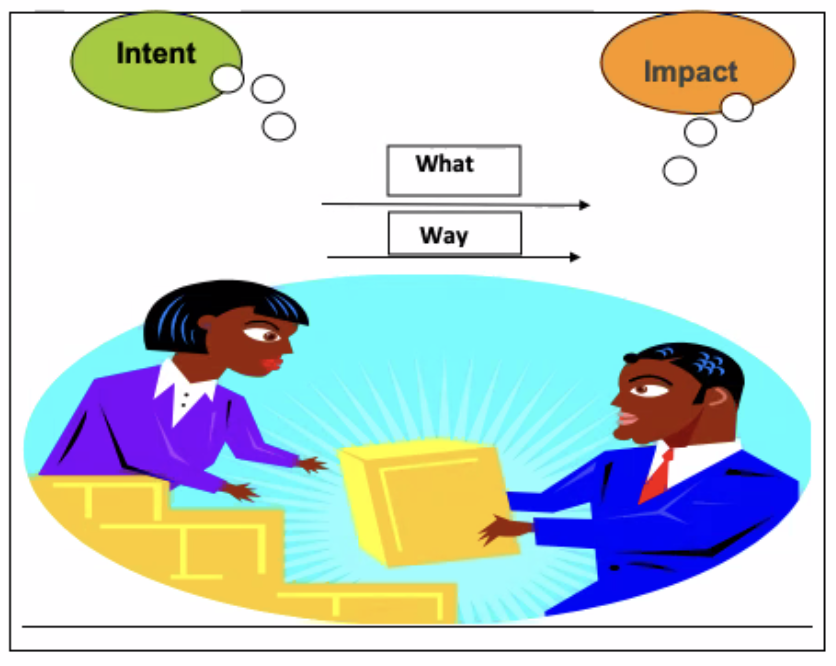Red Zone/Blue Zone, Part 4

Communication and the Red Zone
Part of the problem with the Red Zone has to do with communication. Communication is multi-channeled, and therein lies the problem. I speak words, but I also convey information nonverbally through tone of voice, posture, facial expression, etc. The verbal messages emerge from the intellectual centers of the brain where logic reigns. The nonverbal messages emerge from the emotional centers where my story resides. Notice in the drawing below how these messages are sent.
 Notice that the woman is saying something to the man. She has a particular intent: ‘John, would you put that box over here.’ Hopefully what she intends by her message equals the impact of her message on John. But that isn’t always the case. That’s because communication has more than one channel. My content (what) also carries relational signals in the way that I say things – body language, tone of voice, facial expressions.
Notice that the woman is saying something to the man. She has a particular intent: ‘John, would you put that box over here.’ Hopefully what she intends by her message equals the impact of her message on John. But that isn’t always the case. That’s because communication has more than one channel. My content (what) also carries relational signals in the way that I say things – body language, tone of voice, facial expressions.
The way message emerges from that part of the brain that contains my story, and the central theme of that story. So let’s say my central theme is acceptance, and I want John to move a box. The way I say that to John will undoubtedly be different than if my central theme is control. The acceptance person quite possibly will have more of a placating manner in her voice as she makes the request. The control person could have a demanding non-verbal message as she asks John to move the box.
When I say something to you, my words carry one message, that you hear consciously (the what of my message), and my body language communicates another message (the way of my message), which is communicated by me and registered by you unconsciously. What that means is that I can say one thing (“I really value women and their contribution in the workplace”) and at the same time contradict that message by my body language (I never seek out women for their opinions, and tend to only hear and value contributions by men. Women can be pushy, and I’m into control). Whenever there is a discrepancy between what I say verbally, and how I act non-verbally (a double message), the verbal message is rejected. Also, trust in the communicator is diminished or destroyed. You say that you value women, but your actions don’t support that notion.
I might think that what I’m saying to you is coming across quite logically in the Blue Zone, but my non-verbal messages may convey a completely different message to you, that I am in fact in the Red Zone. I’m in conflict with you over what I thought was the mission of our organization. But I have slipped into the Red Zone, and my actions and non-verbals betray that fact to you.
Postures
As I sink into the Red Zone, I will assume a stylized posture, which becomes part of my non-verbal communication. Often this posture conceals the fact that I am Red Zone (e.g. Computing looks hyper-reasonable). Take a look at the graph below.
Posture Hope for results
Placating. Often used by Acceptance people. So others won’t be mad. “Spare Me”
Blaming. Often used by Controlling people. So others will see me as strong.
“Obey Me.”
Computing. Often used by Survival people. So others will see I’m not threatened.
“Ally with Me.”
Distracting. Often used by Competence people. So others will ignore the threat.
“Tolerate Me.”
Adapted from Virginia Satir, Peoplemaking. (Palo Alto: Science and Behavior, 1972).
If you are working through the Appendix alone, think of the predominate posture you assume when you slip into the Red Zone during conflict. If you are doing the Appendix in a group, discuss with the team the various postures each of you use and experience as things begin to turn Red Zone. It is most helpful to think of concrete examples of conflict that turned Red Zone. It’s usually easier to spot this initially in other people than in yourself. But hopefully, as you become more aware of yourself, you’ll be able to see how you yourself sink into these unhelpful postures.




